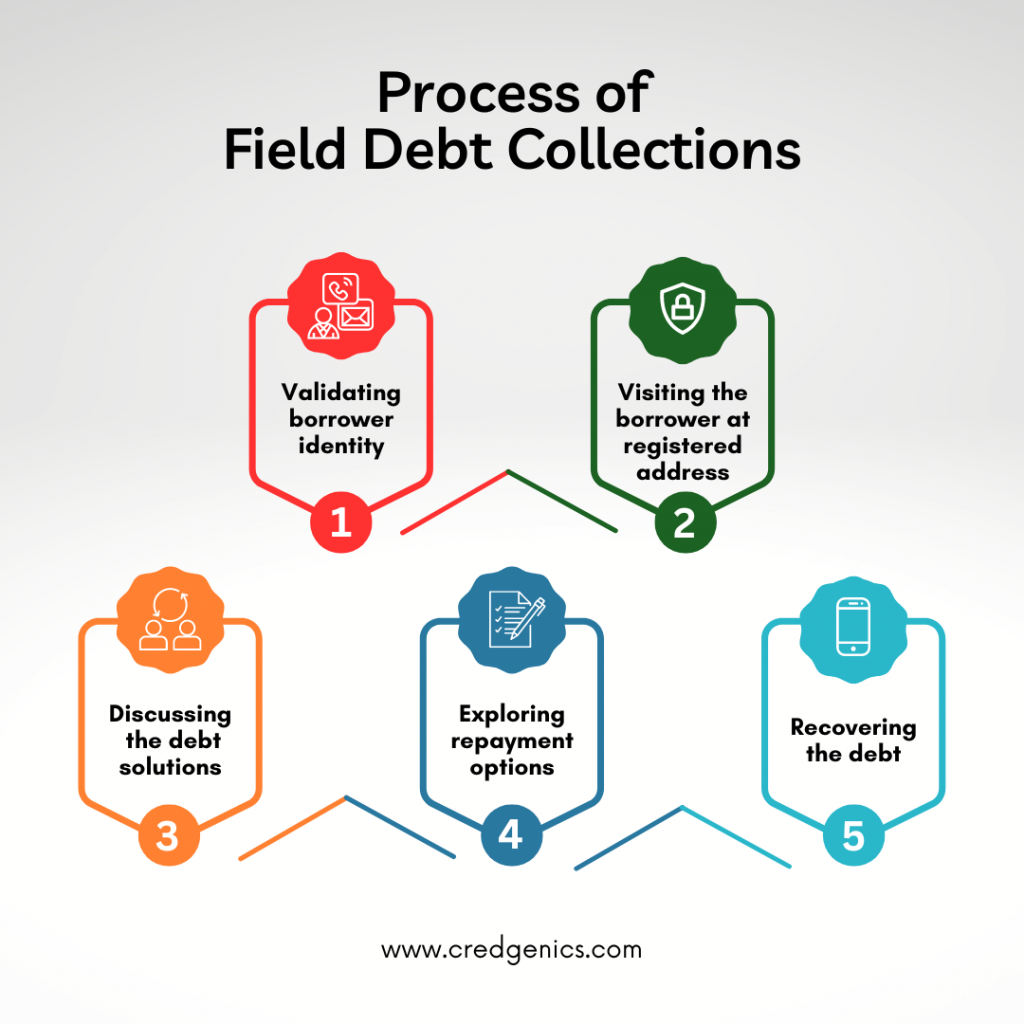Field debt collections is a process that involves the recovery of outstanding debts through face-to-face communication between the debtors and the collection agents. This method is often used when traditional collection efforts, such as phone calls, letters, and emails, have proven insufficient to recover the debt. Professional collection agency’s in-house collections teams typically carry out field debt collections, which creditors authorize to recover debts on their behalf.
Field debt collection agents are trained professionals with extensive debt recovery experience. They are skilled in communication, negotiation, and conflict resolution and thoroughly understand the legal and regulatory framework surrounding debt collection.
The process of conducting field debt collections
The field debt collections process begins with validating the debtor’s identity and the contact information they provided during onboarding. Once done, a collection agent visits the debtor at the registered address.
The agent will introduce themselves, explain the purpose of the visit, and request permission to discuss the various elements of the debt. If the debtor agrees, the agent will review the loan details, including the amount owed, the interest rate, and any penalties or fees that have been added. The agent will then explore payment options with the debtor, such as a payment plan, a lump sum payment, or a settlement.

The right approach to field debt collections
Negotiating a settlement can often be the most challenging part of field debt collections. Debtors may be struggling to pay the total amount owed or may dispute the validity of the debt. On behalf of the lender, the agent may offer incentives to the debtor, such as a rebate on the outstanding amount, or they may agree to consult the lending institution to waive specific fees or penalties. In exchange, the agent can help the debtor make a payment or set up a payment plan.
Debtors may also feel embarrassed about their financial situation or resent the creditor or collection agency. This is where collection agents must handle these emotions with humanity and empathy while maintaining a professional demeanor. They must be skilled in assessing the situation, conflict resolution and diffuse it before it escalates.
Overall, the right approach to field debt collections is one that balances persistence with patience, professionalism with empathy, and compliance with legal regulations. By taking a measured, strategic and respectful approach, debt collectors can build trust and work towards successful debt resolution.
Technology evolution in field debt collections
The challenges associated with the manual processes of field debt collections point for a transformed and technology driven approach by lenders. Advancements in technology are facilitating this rapid shift, allowing lending institutions to streamline and boost their end-to-end debt collections processes. A few of the technological capabilities disrupting field debt collections are:
1. Field force tracking: Field debt collections face a number of challenges, including a lack of communication within teams, paper-based processes, and ambiguous performance metrics. Adding to the lenders’ difficulty is the inconsistency in capturing the location of field agents. Greater transparency and visibility into the activities of the field force allow managers to better monitor the operations throughout the debt collection process. Tech-enabled agent tracking facilitates efficient utilization of field agent resources and accuracy in reporting and recording the activity in real-time.
2. Offline mode for uninterrupted operations: Agent tracking becomes challenging in areas where there is little or no internet connectivity. Visit scheduling, live tracking, recording and reconciliation of collections, and performance management can be streamlined if the field debt collection application or web-based platform can function even with low internet support. This feature also supports the viewing, downloading, and printing of receipts. It enables continuity of collections operations even in remote areas and helps agents accomplish their daily targets.
3. Multilingual support: Imagine a field debt collections agent being unable to transact because of a language barrier. This would stall the recovery and give rise to other inefficiencies in the debt collection process. Depending on the profile of the field agents, limited language support might lead to a lower adoption rate of digitization in field debt collections. In tier-2 and tier-3 cities, this could pose a huge challenge because the adoption of the English language is lower as compared to metro cities. To close this gap, SaaS-based field debt collection platforms have come up with tech-enabled multilingual support to enhance the agent experience and boost the adoption of digital.
The legal ecosystem of field debt collections
The regulatory landscape for field debt collections in India is comprehensive. Lending institutions must abide by the guidelines that the Reserve Bank of India has laid out in the Fair Practices Code (FPC). In addition to limiting the frequency and number of calls that lenders can make to borrowers, RBI also prohibits collection agents from threatening or coercing them in any way during a physical visit. Any digression from compliance with ethical and legal standards has implications for the lenders. The resolution must be reached amicably by stating the facts to the borrower and giving them the right to dispute the debt.
In addition to complying with the FPC, field debt collection agents must adhere to state and local laws governing debt collections. These laws vary by state and may impose additional requirements on collections agencies, such as licensing, bonding, or registration.
The way forward: Using digitization to streamline field debt collections
Given the complexities of debt collections, the regulatory landscape of field debt collections, the growing need for operational transparency, and the importance of debtor privacy and dignity, lenders are gradually transitioning to digitization in the field debt collections process. Many players in the market acknowledge the usefulness of a SaaS-based field debt collections application that can help lenders and borrowers achieve greater flexibility by addressing their respective concerns around debt repayment. With features such as multilingual support, transparency in monitoring agent activity, offline functionality, and uniformity in reporting, such applications are facilitating a shift in the collections landscape at a rapid pace.
Moving the various stages and functions onto a mobile application simplifies the collections process and agent tracking, in addition to transforming the customer experience. A growing number of lending institutions are taking the digital route to field debt collections and achieving a holistic recovery mechanism. In the near future, various aspects of the field debt collections process will transition wholly to digital platforms, adding another layer of precision to India’s already-evolving debt collection landscape.
Watch this award-winning case study to discover how Credgenics CG Collect helped IREP Credit Capital to adopt digitized field collections processes seamlessly, which resulted in 50% surge in field visits, 50% growth in the number of daily field visits and 3X recovery through digital mode.
FAQs:
1. What are the responsibilities of a field debt collections agent?
A field debt collections agent is an executive working on behalf of the lending institution, assigned to engage with a borrower in person to recover the debt. This method is typically used when other forms of communication, such as emails, calls, and letters, have not resulted in the recovery of the debt. A field debt collections agent is responsible for discussing the possible methods of resolving the debt and assisting the borrowers in doing so, using preferred channels of repayment.
2. What skills should a field debt collections agent have?
Professionals tasked with the job of field debt collections undergo training and accumulate significant experience in debt recoveries and resolutions. They have expertise in communications, negotiation, and conflict resolution. They also possess a deep understanding of the legal and regulatory framework that governs debt collections.
3. What is the process for field debt collections?
To initiate the debt collections process, the first step is to verify the debtor’s identity and the contact information provided at the time of onboarding. The debt collections agent will then visit the debtor at their registered address. The agent will seek permission from the borrower to discuss the outstanding debt, review the loan details, and discuss any associated charges or penalties. This approach also ensures that the borrower’s financial constraints are considered while facilitating the successful resolution of the outstanding debt.





